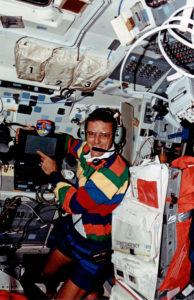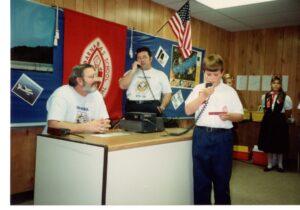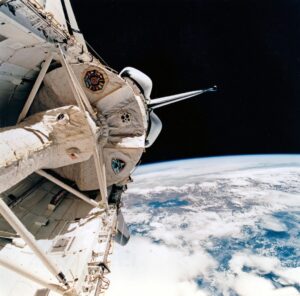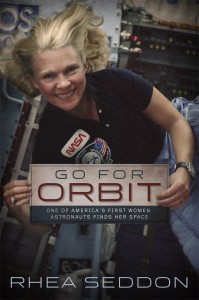My Best Space Moment
How do Astronauts keep in touch with their families when they are orbiting the Earth?
Communicating with loved ones became more sophisticated over time. In the beginning, families could send up brief messages with other NASA information to the Shuttle’s antiquated printer. Later on, those few words could be sent with packets of information to our onboard computer. Neither of those methods were private, and so they were painfully terse: “Miss you!” “Kids say HI.” or “Come home soon.”
Some ingenious engineers, communications specialists, and Astronauts unearthed a use for old-fashioned technology to improve family communication. By the 1950s, wireless voice transmissions became possible and allowed amateur radio operators—called “ham radio” users—from all over the world to communicate with each other using special frequencies.
Why not talk to shuttle crews that way?
The results? Remarkable moments in space for me.
By putting a ham radio antenna in a Shuttle window, families and others could have short conversations with the Astronauts. As the ability to talk to space evolved, NASA began a program to let schools apply for an opportunity to speak to crew members on the Space Shuttle. My son, Paul, was 11 when I flew on my third mission in 1993. His school, St. Barnabas in Houston, applied to speak to me, and the fun began when his fifth-grade class was accepted. They had to learn all about radio communication and radio voice protocols. Each student would prepare and practice asking their question using equipment provided by a local ham radio operator.
Paul worked hard on the questions he might have an opportunity to ask. We went over his material many times at home before I had to go to Florida for my launch. During our last practice session, he seemed a little nervous.
“What’s the matter, Paul, are you worried you won’t remember what to say or do?” I said.
“No, Mom…I’m just afraid you’ll say something mushy when you talk to me and my friends will laugh.”
So, I promised just to answer his fine questions and not embarrass him.
My flight (STS 58) launched on October 18, and we went to work on our life sciences experiments. When the day for our conference with Paul’s school arrived, my crewmate and our amateur radio specialist Bill McArthur set up the radio in Columbia’s window that overlooked our payload bay. We made contact with the school, and the questions began. The hard work the students had put into their opportunity showed, and their transmissions were clear and concise, as was Paul’s.
At the end of our planned contact period, I could hear crackling sounds on the radio that meant we would soon lose contact.
“Thank you for your great questions today, St. Barnabas. I’ll see you back on Earth soon,” I said.
Then came what I will always recall as the most memorable event of my spaceflight career. As I looked out the Shuttle window at the blackness of the void of space, a little voice came over my headset.
“I love you, Mom. Have a safe trip home.”
– Rhea
If you’d like to receive my blog to your inbox each month, we’d love to add you to our email list. If you have not yet signed up, please do so today by clicking here.
Follow me on LinkedIn and Facebook .
Subscribe to Dr. Seddon’s YouTube Channel here!






What is/was your ham radio callsign Dr. Seddon?
Oh, man! That brought a tear to my eye! Thank you, Dr. Seddon.
I remember reading this piece in your book. Wonderful book!!! Loved learning more regarding the space program from someone in the middle of all…especially from a woman!!!!
The magic of communications is why I got my amateur radio license.
Hello!
Other prominent ham radio operators in space:
Eileen Collins KD5EDS
Pedro Duque Kc5RGG
Dave Leestma N5wQc
Barbara Morgan KD5VNP
Yuri Onufrienko RK3DUO
Goddard Amateur Radio Club WA3NAN (NASA employees from Maryland)
And two members of 1978 class!:
Kathy Sullivan N5YYV
Shannon Lucid R0MIR
Dr. Seddon, that was such a wonderful story to tell the world! Reaching out to students and seeing the result is what makes the amateur radio team keep volunteering with schools and education groups. We still do this, and it’s now ARISS, Amateur Radio on the International Space Station for the ISS crews. Thank you! Rosalie
A should for your kid, get it!